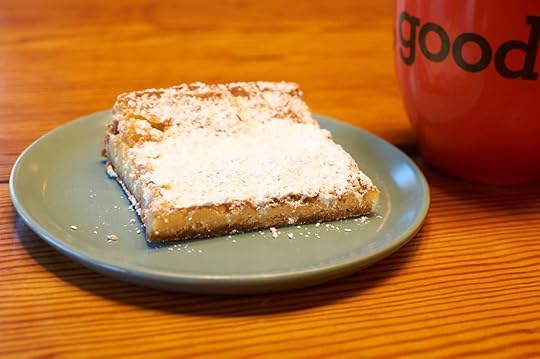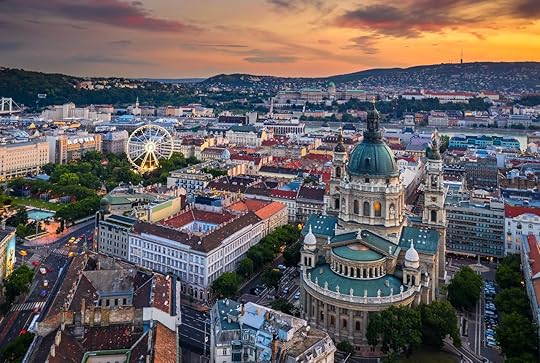Matador Network's Blog, page 632
July 7, 2021
Tennessee is giving 10,000 lucky travelers flight vouchers to come visit

It’s official: Tennessee’s ready to welcome back travelers. And it’s providing an incentive.
Together with country superstar Brad Paisley, Governor Bill Lee recently announced a state-sponsored airline voucher giveaway for travelers who book a trip through Tennessee On Me. The vouchers — which are redeemable for flights to Chattanooga, Knoxville, Memphis, and Nashville on American, Delta, or Southwest airlines — are worth $250 each and will be awarded to a total of 10,000 travelers. The giveaway is first-come, first-served, though, so you better book fast.
On the state’s decision to organize a tourism campaign, Governor Bill Lee said in a statement, “Tennessee is known around the world for its music, scenic beauty, and iconic attractions. We’re ready for people to come to Tennessee ‘on me’ to enjoy live music all over the state created by our talented musicians and songwriters like Brad Paisley.” Paisley’s most recent hit, “City of Music,” celebrates all things Nashville, which travelers are being encouraged to do as well.
How to win a voucher is simple: All you have to do is book a two-night stay at one of the state’s 60-plus participating hotels between July 11 and December 30, 2021, and flights on one of the participating airlines. One night of your stay must fall on a Sunday, Monday, Tuesday, or Wednesday. Then, if yours is one of the first 10,000 bookings, you’ll receive a voucher via email between 48 and 72 hours after you click submit. Read the full list of rules and details here. 
The post Tennessee is giving 10,000 lucky travelers flight vouchers to come visit appeared first on Matador Network.
Why Tamarindo, Costa Rica, is an ideal base for solo travelers

The Pacific coast of Costa Rica entices with its stunning beaches, lush green mountains, national parks, and abundant wildlife. When you’re traveling alone, the addition of a laid-back town that you can use as a base for activities is key. In the country’s northwest Guanacaste Province, Tamarindo is the ideal beach town for solo travelers — a walkable place that offers plenty of relaxed activities and opportunities for cultural immersion.
Tamarindo offers solo travelers the right mix of adventure and cultural activities. And despite its crowded beach town reputation, Tamarindo has the same warm and relaxed “Pura Vida” vibe that embodies the best of Costa Rica. Literally “pure life,” pura vida is more than just a phrase; it is a way of life and greeting, much like aloha is in Hawai’i. Here’s how to make the most of it.
Getting thereI traveled to Tamarindo via Miami, arriving in Costa Rica’s second major airport in Liberia. There, a taxi whisked me off to Tamarindo, a peaceful ninety-minute drive away. On our way, I took in the landscape: smooth roads, roadside food shacks called “sodas,” fruit stands, and lush forests as far as the eye can see. Costa Rica is one of the most eco-friendliest countries in the world with nearly 30 percent of its land reserved as national parks or private reserves, a huge draw for adventurous and eco-conscious travelers.
I could tell we were approaching Tamarindo as our travel slowed a bit with a few more cars on the road. Sidewalks — just a sandy part of the road — looked increasingly busier with people in flip flops and bathing suits. Beach-facing resorts, restaurants, cafes, craft stores, and surf shops came into view. Most importantly, I got a whiff of salt water, which means one thing — the beach was near.
Stay in an eco-hotel
Photo: Hotel Boruca Tamarindo/Facebook
You don’t need a plush bank balance to afford an eco-hotel, and there are many inexpensive and green-conscious hotels in Tamarindo. I lucked out with Hotel Boruca, a five-minute walk from Playa Tamarindo. It has a pool area surrounded by large coconut and shade trees, which are a boon in hot weather. If that’s your thing, you can do nothing but lounge at the poolside with a drink in hand and watch a family of monkeys jump from tree to tree in play. They come as far as the top of the fence that separates the property from its neighbor, but they do not enter the compound.
The rooms are clean with wooden bed frames, windows or a sliding door for natural light, the latter of which have room darkening curtains that must be drawn when the air-conditioner is on. There are notes to switch off lights and the a/c when going out or when not in use. This is part of Costa Rica’s engagement in tackling climate change as these measures save energy. Lastly, a cool feature at this hotel is the eco shower made of stone that allows for natural drainage into the stone cracks.
Celebrate your inner beach bum
Photo: Fotos593/Shutterstock
If all you want to do in Tamarindo is lounge beachside until your departure, you will not be blamed for your decision because the ambience is relaxed, the town is safe for a solo female traveler, and the people are super friendly. Within Tamarindo are two white-sand beaches accessible on foot — Playa Tamarindo and Playa Langosta — and they are as different as night and day.
Where Playa Tamarindo is within Tamarindo beach town and is a 10-minute or less walk from surrounding hotels and beach-side resorts, Playa Langosta is a 20-minute walk through quiet, residential areas with private villas, resorts, and apartment hotels. Playa Tamarindo is popular with tourists because of its tiki bars, cafes, live music, crowds, and surfs, while Playa Langosta is more popular with surfers for its much stronger surfs and epic sunsets. Whichever you choose, grab some drinks and snacks, secure a deck chair and parasol, and plant yourself on the sand.
Unleash your adventurous side at the playas
Photo: riekephotos/Shutterstock
Alternatively, indulge in activities at Playa Tamarindo like stand up paddle boarding (SUP), kayaking, ATV rides, boat tours, and even a sunset catamaran tour available from activities promoters at the beach. You cannot miss their advertising on the roadside or at beach stands — but, if you prefer a referral, ask any of the friendly locals or long-term expats for options. All levels are welcome so a novice surfer or paddle boarder can learn on calmer tides. All beaches have identical water activities, so if you miss one, you can get it in another.
If adventure for you is more about taking in the beachside wildlife, head just a bit north to the Las Baulas National Marine Park — an important site for leatherback turtle conservation. The park is open daily from 6:00 AM to 6:00 PM, but only until 5:00 PM during turtle nesting season from October through February. At that time — either when turtles come to nest or the hatchlings emerge and head out to sea — you may be able to participate in guiding tours designed to protect the endangered turtles.
Take a day trip to Samara Beach
Photo: LMspencer/Shutterstock
Guanacaste Province is packed with other inviting beaches in even smaller beach towns. And while they are lovely beach towns for solo travelers, we think their small size makes them best suited as day-trip destinations. If you can cram a day trip into your itinerary, Samara Beach is a great option.
Samara is two hours from Tamarindo, through the towns of Santa Cruz and Nicoya. The ride is on smooth and fairly empty roads flanked by reforested trees on either side, planted as part of the Costa Rican government’s bid to offset greenhouse gas emissions and tackle climate change.
Samara is much smaller, low-key, and definitely less crowded than Tamarindo, but not without the Pura Vida atmosphere that is Costa Rica’s mantra. Rent an affordable deck chair and parasol, order some roasted snapper, fries, cold beverage, and people-watch your time away. If you choose to, partake in activities like stand up paddle boarding (SUP) or surfing lessons.
You can also kayak through the mangroves in Ora River between Samara and Playa Camaronal. You could do a horseback beach ride starting at $20 for a one-hour ride along the beach and to a nearby eco-friendly reserve. To check out the wildlife in the lush mountains that overlook the beach, you could take a ride in a gyrocopter. Gyrocopter tours start at about $130 per person for a 20-minute flight and go up from there.
Alternatively, yoga is as popular in each of these beach towns as surfing, and you’ll find opportunities for beach-side yoga in Samara and elsewhere.
Get your food fix at affordable local restaurants, right on the beachAll that lounging, watersports, and crisp air leaves one peckish, and you are spoiled for choice with food on the streets of Tamarindo. Tamarindo has a large expat population, predominantly Canadians and some Italians, who immigrated decades ago and have beach-centric businesses in town.
You will find popular spots like Jonny Tamarindo. It’s the in-spot and extremely popular with the expat Canadian community and tourists alike for its live music, prime beach-side location, food, and cocktails. It gets full in late afternoons as its sunset views are breathtaking. The best breakfast is at NOI Bistro, which serves a delicious shredded coconut pancake stack with orange juice for breakfast that is fuel for your day of activities. It is also part of a hostel, so it is a prime spot to make new friends, ask for recommendations, or people-watch.
There are also taco spots, sushi, Thai, Vietnamese eateries and food trucks for a wider culinary variety. For lunch or dinner, seek a seafood spot at many of the beach restaurants and have your fill of affordable lobster dishes. If available, try the national dish of gallo pinto or “spotted rooster,” made from stir-fry rice and beans with vegetables and some fried plantains. Wherever you eat, finish with a Pura Vida cocktail as you listen to live music at Jonny Tamarindo’s and watch the setting sun on the beach.
Browse Indigenous arts and crafts stores, then indulge in chocolate
Photo: Stefan Milivojevic/Shutterstock
You cannot miss the craft stores in Tamarindo with their attractive collection of Indigenous masks, hammocks, jewellery, baskets, art, and adornments. These craft stores are expat-owned and either source from local indigenous communities in Costa Rica or imported from South America or Bali — so always ask if you are interested in product sourcing.
Nevertheless, you will find many intricately crafted Boruca masks, baskets, and hand-drawn art. Boruca are a indigenous community famous for their carved masks, and you’ll find them in every craft store. Additionally, visit the Chorotega indigenous community in Guaitil, thirty minutes outside Tamarindo, and watch their sculptors create pre-Columbian-style pottery with clay and natural dyes; these are sold as their main source of income.
Costa Rica’s indigenous community makes up one percent of its total population. There are Indigenous reserves country-wide that fuse traditional activities into Costa Rica’s tourism initiatives supporting cultural preservation.
Another cultural activity a solo traveler can indulge in is a chocolate tour. Costa Rica is famous for the cacao bean — known as the “food of the gods” to the Mayan civilization — that gives us chocolate products and is still a large part of the country’s economic and Indigenous activities. You’ll find many chocolate tours in the area, but we recommend Reina’s Chocolate Tour in Tamarindo which offers chocolate tasting options, chocolate tea, organic Costa Rican chocolate, and chocolate drink recipes.
Soar in the clouds on a zipline or pound the pavement
Photo: Black Stallion Hills/Facebook
Ziplining was invented in Costa Rica over 50 years ago by a biologist who wanted a means to study the forest canopy. Near Tamarindo, you can try your hand at platform ziplining. Book a tour with the Pinilla Canopy Tour, the Monkey Jungle Canopy Tour, or the Black Stallion Eco Park & Estates — all of which are relatively close to Tamarindo. It is an incredible feeling to quietly soar a few hundred feet above ground.
The best way to acquaint yourself with Tamarindo is by walking the length of its main street, Calle Central, northwards until the boisterous nature of the town subsides and then turn back. Pop into shopping malls, boutiques, eco-friendly shops, ice cream bars, and restaurants along the way. See what activity catches your fancy from the tour offices and book it on the spot, patronize Indigenous craft sellers in mobile kiosks, and indulge in the friendly “Pura Vida!” greetings from locals and fellow tourists alike. And hopefully, at the end of your stay, you can take some of the Pura Vida vibe back home with you. 
The post Why Tamarindo, Costa Rica, is an ideal base for solo travelers appeared first on Matador Network.
For just $173k you can own this Scottish village and they’ll throw in a free ghost

If you’re thinking about buying land or you just have a deep love for haunted historical sites, this haunted village in Scotland is just the place for you.
The ruins of the Old Village of Lawers located in Loch Tay, Perthshire, which is an hour and 40 minutes away from Scotland’s largest city Glasgow. This village was abandoned in 1926 is now on the market for ownership for £125,000 ($173,000).
According to the Goldcrest Land and Forestry Group, this haunted village is over 3.31 acres with remarkable historical and romantic connections like semi-ancient native woodland, a private beach, Riparian trout fishing rights, and ruined buildings. Take a look at the lush landscape below.
Let’s not forget the ghost that comes along with the village–the Lady of Lawers. The Lady of Lawers is said to haunt the village. According to Goldcrest, the Lady of Lawers is remembered for various prophecies that were said to have come true, like the invention of the railway and the destruction of a local church by a nearby tree.
Buyers looking to make an offer on this haunted village can contact selling agents to note your interest. For more information on the property itself, you can visit Goldcrest or download the brochure here. 
The post For just $173k you can own this Scottish village and they’ll throw in a free ghost appeared first on Matador Network.
No St. Louis trip is complete without tasting the city’s signature gooey butter cake

St. Louis is the home of storied culinary novelties such as toasted ravioli and cracker-thin pizza crusts, but more than any other food from the city (or the state of Missouri), gooey butter cake is arguably the most iconic. And in this town, seemingly everyone has opinions about it: where to find it, how to make it, and when to eat it.
“People are opinionated about gooey butter because it’s such an adaptable cake,” says Molly Killeen, a St. Louis native whose gooey butter cake recipe was featured in the New York Times. “The simplicity of the original ingredients opens the door to whatever variations people can dream up, and the combination of a sweet topping with a more bready crust makes the cake appropriate for anything: breakfast, teatime, birthdays, office parties.”
It’s believed that this thin, sticky dessert first appeared in the 1940s, though its inventor’s name is disputed. However, most agree that it’s likely product of a German baker who made an error and switched the proportions of butter and flour. The result? A no-frills cake no more than 1-inch thick with a sweet dough base topped with the gooey: a jiggly, buttery layer that verges on custard and is often dusted with confectioners sugar.
“Afternoon coffee or tea is a perfect time for it,” says Tim Brennan, a two-time James Beard Award winner and owner of Cravings Gourmet Desserts who enjoys the cake for breakfast, which is when his mother served it. “It’s not a sophisticated dessert. It’s rustic and simple.”
Two versions of gooey butter cake are the most common throughout St. Louis. There’s the yeast-risen, sweet dough original, and then there’s the one popularized by home cooks that typically is made with cream cheese and store-bought cake mix. Both are served warm or at room-temperature in brownie-like squares. When I first moved to Missouri, I was welcomed to my new home with a pan of the latter. It is an unapologetically rich dessert, tiptoeing toward the wincing sweetness of children’s candy. I devoured every sticky crumb.
Killeen’s recipe adheres to the traditional yeast base, while Brennan plays with a few different renditions of his own that have come about from his 35 years on the local gooey butter cake scene. “It’s a vehicle that I think translates into all sorts of applications,” Brennan says. “Plain vanilla? Not my choice, because it’s too sweet. Nostalgia can only carry you so far.”
Brennan raises a good argument, proven by the abundance in gooey butter cake flavor varieties in town. But perhaps nostalgia itself is ultimately what powers this dessert’s enduring legacy.
“If gooey butter cake was truly born of an error, as the tale is told, it seems to me that it lived on because there is a spaciousness to life in Missouri,” Killeen says. “There is no need to quickly toss things out and move on to the next. There is room. There is time. St. Louisans are proud of what they know is true, and this cake, made up of the most simple baking ingredients, is greater than the sum of its parts.”
With that in mind, perhaps there’s no singular best gooey butter cake. And in a place where this humble delicacy is everywhere from neighborhood groceries to chic coffee shops, knowing where to start is tough.
Here’s where to try the city’s most noteworthy takes on this dessert, then come to your own conclusions about which is your favorite.
Where to try the best gooey butter cake in St. Louis, Missouri
Photo: Park Avenue Coffee/Facebook
Park Avenue Coffee: This shop offers more than 70 varieties of gooey butter cakes, from summery peach or lemon varieties to more unexpected versions like bacon. But the top seller is the original “Mom’s Traditional,” which won a distinction from Food Network as the best in town. Choose from three locations, but the original in Lafayette Park is the most charming.
Where: 1919 Park Avenue, St. Louis, MO 63104
Federhofer’s Bakery: The Federhofer name is famous in St. Louis for its decades-long reputation as one of the best bakeries in the metropolitan area. Sticklers for tradition, the bakery avoids both cream cheese and powdered sugar in its take on gooey butter cake. This mom-and-pop bakery serves up gooey butter cake in five different flavors, slinging out more than 60 pans a week.
Where: 9005 Gravois Road, St. Louis, MO 63123
Russell’s on Macklind: This sweet neighborhood spot offers a bar cookie version composed of three layers: a thick, buttery shortbread base, a layer of creamy goo in the middle, and a crisp, merengue-like topping that shatters at first bite. The original and chocolate won’t disappoint, but the surprising tartness of its seasonal fruit varieties cuts through the sweetness for a more sophisticated bite.
Where: 5400 Murdoch Ave., St. Louis, MO 63109
Missouri Baking Company: Gooey butter cake likely originated with a German baker, but the family owned, Italian-American Gambaro spot has proved to be just as adept at creating delicious gooey butter cake for nearly a hundred years at the historic location in The Hill. Their version of gooey butter cake is an actual cake (as in, more dense and less pudding-like texture) made with sweet dough and almond paste. Flavors reflect the changing seasons — brown sugar pecan in the fall, triple berry in the spring and summer.
Where: 2027 Edwards St., St. Louis, MO 63110
Cravings Gourmet Desserts: Tim Brennan’s bakery is known for more than just gooey butter cakes, so nothing offered will disappoint. To this James Beard Award-winning dessert chef, the ideal gooey butter cake has crunch and cream, acid and sugar. Here, expect to find individual gooey butter cakes baked in generous 4” x 4” pans, that deliver a perfect ratio of chewy edges and gooey centers.
Where: 8149 Big Bend Blvd, St. Louis, MO 63119
Gooey Louie: No St. Louis gooey butter cake tour would be complete without a taste of Gooey Louie, a Chesterfield bakery that has been consistently credited with the best gooey butter cake in the city. This family-owned business doesn’t just make full-size and individual portions, but gooey butter cake cookies and gooey butter ice cream, too. Find them at shared kitchen bakeries like The Bakers Hub in Chesterfield.
Where: 67 Forum Shopping Center, Chesterfield, MO 63107 
The post No St. Louis trip is complete without tasting the city’s signature gooey butter cake appeared first on Matador Network.
Watch: This insane fireball just exploded over Idaho

Fireworks weren’t the only thing lighting up the sky this past weekend.
A video posted to the Idaho Weather Watchers Facebook page on July 4 by member Jordan Ragsdale captured a massive fireball blazing across the sky over Eagle, Idaho, in the Boise Foothills the previous evening around 10:52 PM MDT. Eyewitness reports submitted to the American Meteor Society indicate that the epic fireball was also visible in parts of Montana, Nevada, Oregon, Utah, Washington, and Wyoming.
In the video, which was originally posted to Ragsdale’s Instagram, the meteor is seen plummeting toward the earth before exploding in the atmosphere, creating what’s known as a bolide. The footage is both eerie and extraordinary as the bolide stains the cloudy night sky a glowing green-blue, then creates a blinding white flash, bursts into a fiery ball for a split second, and finally extinguishes as the meteor continues to fall.
Meteors burning up in Earth’s atmosphere is not uncommon. In fact, it’s a daily occurrence. Visible fireballs like the one seen this past weekend only occur roughly once per year, on the other hand, with the largest among them only occurring once every two to three years.
If you missed this one, check out the video below to witness the epic phenomenon. 
The post Watch: This insane fireball just exploded over Idaho appeared first on Matador Network.
What's your adventure travel style?

Some adventure travelers chase wild waves across Earth’s farthest-flung coasts. Some aim vertically, pursuing hair-raising pitches on their bucket lists of rock-climbing routes. Some trust their adrenaline rushes to the wind and water — others create their own momentum, flying down slopes and trails.
No matter the sport, these adventure travelers have one thing in common: They don’t just chase stoke, they pass it on. And few things spread stoke like sharing ice-cold brews and travel stories in the great outdoors. Even better is when those brews don’t compromise your adventures. Enter the non-alcoholic, low-calorie, and hangover-free beers from Athletic Brewing Company, a craft brewery built by outdoor adventurers, for outdoor adventurers.
So if you’re hungry with wanderlust and craving a cold one — ideally shared on the beach or atop that summit — look no further. The perfect non-alcoholic craft beer exists for every kind of stoke-chasing. But first: What kind of adventure traveler are you?
Explore the full Athletic Brewing beer collectionAre you a globetrotting marathoner?
Photo: lzf/Shutterstock
Sure, you could turkey-trot or catch a marathon close to home, but it’s not just miles you’re after. As a globetrotting marathoner, you crave races with a side of rad. And why wouldn’t you? With 26.2s winding along China’s Great Wall or Big Sur’s jagged coasts, this world’s packed with epic marathons.
Do jaw-dropping vistas and world wonders make those miles easier? Hardly. But easy’s not your goal — you’re all about adventure, and the best way to celebrate those long-distance finishes is your signature Athletic beer: the non-alcoholic Run Wild IPA, a refreshing session brew with a blend of five Northwest hops that can actually refuel you for the next destination race on your roster.
Your beer: Run WildAre you a coast-scouting kitesurfer?
Photo: Wallenrock/Shutterstock
When wind calls, kitesurfers answer — and for those with an incurable case of wanderlust, nothing beats big air off a shoreline thousands of miles from home. You daydream about downwinders along the white-sand coasts of Brazil and Morocco, although, let’s be real: Tropical destinations aren’t the only spots on your radar. You’re just as happy launching in Hawaii as you are in frigid Alaska, where the mountain-flanked Harding Icefield pairs kite power with fresh powder.
No matter the backdrop, the light-bodied non-alcoholic Downwinder Gose, with hints of sea salt, coriander, and lime leaf, is the best way to end a windy day on the water.
Your beer: DownwinderAre you a boundary-pushing rock climber?
Photo: Photobac/Shutterstock
Rock climbing at the local gym may be fun, but for you, colorful holds are just a holdover until you can get back on the road. As a boundary-pushing rock climber, you’re constantly plotting trips to the world’s best pitches, from Yosemite and Italy’s Dolomites to Rocklands, South Africa, and Kentucky’s Red River Gorge (or, as you and the climbing community better know it, “The Red”).
You take that boundary pushing seriously, with an appetite that’s just as satisfied by ice climbing and bouldering as it is deep-water soloing and free climbing. And trust us, nothing calms those sore, chalky hands like an ice-cold Upside Dawn, a non-alcoholic golden ale brewed with Vienna malt and English and traditional American hops, expertly crafted to remove gluten.
Your beer: Upside DawnAre you a summer-chasing surfer?
Photo: Rawpixel.com/Shutterstock
For the summer-chasing surfer, there is no surf season — it’s a year, 365 days, and it’s all about where you look. Of course, you know that already. That’s why your windfinder app’s packed with coasts you’ve yet to tackle. But you will, that’s a given — and you’re slowly cranking through a break bucket list that’s now on its third page.
While you love the summer waves of Mexico and Tahiti, you’re equally up for surfing chilly extremes, whether it’s under the auroras in Iceland or across the unexpected swells of North America’s Great Lakes. Few things stir the stoke like Athletic Brewing’s non-alcoholic Cerveza Atletica, a blend of Vienna and Munich malts with light spicy and floral notes from German Hersbrucker hops.
Your beer: Cerveza AtleticaAre you a black-diamond-hunting snowboarder?
Photo: muroPhotographer/Shutterstock
If your list of bucket-list first tracks spans slopes on every continent — and yes, that includes Antarctica — then you’re definitely a black-diamond-hunting snowboarder. You’re always searching for fresh powder and new terrain, be it crushing the Swiss Alps or hitting hidden peaks in the backcountry of Hokkaido and Honshu, Japan. Come dawn patrol, you’re up and out with the best of ‘em. By dusk, you’ve yet to leave the slopes.
And, while après ski doesn’t always nab a spot on your snowboarding itinerary, the award-winning All Out Stout, a non-alcoholic and full-bodied brew with a roasted finish, absolutely should.
Your beer: All OutAre you a century-crushing cyclist?
Photo: Maxim Petrichuk/Shutterstock
A 100-mile century ride is the bike world’s ultimate endurance test, and as a century-crushing cyclist, you likely have some ambitious ones under your belt. But you’re just getting started. Where an average traveler sees an Instagram-worthy road trip, you see a string of 100 scenic bike miles, with everything from the dense Denali wilderness to the seas, mountains, and volcanoes of New Zealand as a tantalizing backdrop.
Does a century take time and training? Obviously. It’s hard work preparing for seven straight hours in the saddle. But that doesn’t bother you. You know tough training is worth the reward — like the non-alcoholic Free Wave Hazy IPA, a mouthwatering blend of Amarillo, Citra, and Mosaic hops. Which also, incidentally, doubles as a pint of ice-cold incentive. Throw one back, and it’s full steam forward, without compromise. 
The post What kind of adventure traveler are you? appeared first on Matador Network.
July 6, 2021
Everything you need in your pack to travel to Southeast Asia

We hope you love the travel gear for Southeast Asia we recommend! Just so you know, Matador may collect a small commission from the links on this page if you make a purchase. Listed prices are accurate as of the time of publication.
Southeast Asia’s beaches, lush landscapes, dynamic cities, and delicious food make the region a must-see for many international travelers. Before you embark on the journey of your lifetime, you’re going to need a few essentials, and perhaps the odd luxury. We’ve compiled what you need as far as travel gear for Southeast Asia in 2021. Let’s get down to it.
1. Osprey Farpoint 55 Travel BackpackLet’s start at the beginning. You’re going to need a bag. Countless travelers swear by the Osprey Farpoint 55 Travel Backpack. Accommodating 55 liters of clothes, gear, and memories, this lockable U-zip backpack is the optimal size for travelers working their way around Southeast Asia. The detachable daypack is perfect for tours, and the stowaway back panel provides easy access to everything in the pack. Oh, and you’ll also look fully legit.
Price: $102.14 — $179.95
2. Durable PonchoLove it or hate it, monsoon season is a fact of life in Southeast Asia, and it usually hits between June and October. This durable polyurethane-coated polyester taffeta poncho is one of the most important pieces of travel gear for Southeast Asia and comes outfitted with rust-resistant snaps and a taped seam to keep out even the most overachieving of raindrops. Weighing in at nine ounces, this raincoat is not only lightweight but comes with a full-cut integral hood that adjusts with a drawcord.
Price: $15
3. Merino wool shirtsMuch of Southeast Asia is hot and humid. Nothing ruins a day of exploring faster than being covered in sweat 10 minutes after you head out. To prevent this, merino wool is an absolute necessity. These merino wool shirts come in a variety of colors and can be worn multiple times between washings, so you can load up a few and eliminate the daily decision of which shirt to choose. There are options for men and women, and the women’s option comes with a free pair of merino wool socks for each shirt purchased. This tank-top option for women is functional and durable, as well.
Price: $44.99
4. Hat and sun protectionProper sun protection including a hat, sunscreen, and sunglasses are key for those hot, humid, and sunny days. We recommend our favorites below, including reef-safe SPF 50 sunscreen and functional hats.
Price: Varies
5. Travel toiletry kitToiletries are a must, no matter where you go or how you get there. The women’s option, from BAGSMART, unfolds to display your cosmetics and necessities, then packs back up into a TSA-approved, easily packable size. Elviro’s men’s kits are perfect for backpacking because they’re small but still hold everything you need, from toothpaste to a shave kit and everything else.
Price: About $30
6. GoPro HERO9 Black Camera with travel kitThe GoPro, once synonymous with bros chucking themselves from mountain tops and chest-bumping after the descent, has improved by leaps and bounds in recent years. The GoPro Hero9 comes with up to 5K visual capacity and also scales down to 4K, 2.7K, 1440p, and 1080p. Fully waterproof down to 196 feet, it’s the classic companion for when you’re diving in any of Southeast Asia’s crystalline coastlines. The travel setup comes with a 128GB microSD card, dual power charger, cleaning kit, and extra batteries.
Price: $499
7. Logitech Ultimate Ears UE WONDERBOOM 2 Bluetooth SpeakerUE WONDERBOOM 2 is the new mainstay of UE’s ultra-portable speaker line. The squat, beer can design is not only waterproof, but floats too. We’ll let you imagine for yourself the pool party options available here.
Price: $83.29
8. Saalt Menstrual Cup Duo PackReusable, travel-safe menstrual cups can come in pretty handy if you’re up a mountain, miles from a store, or on a secluded island. Composed of medical-grade silicone, this mooncup will save a life and space. When your menstrual cycle hits, Saalt has got your back with this outstanding product of the highest quality.
Price: $48
9. First Aid Kit — 100 PieceA Southeast Asian hospital visit is not on travelers’ bucket lists, and this is one reason why this 100-piece first-aid kit is among the most important pieces of travel gear for Southeast Asia. Both durable and compact, this paramedic-in-a-bag includes a CPR Mask, blanket, tourniquet, and all the basics. Oh, and if you’re suffering from a UBI (the professional medical term for Unexplained Beer Injury), the bandaids will also come in useful.
Price: $13.75
10. Anker PowerCore Speed 20000 Power BankWith over 20 million users of Anker products in the US alone, there’s a reason why this portable charger for travel utilizing Qualcomm Quick Charge 3.0 (24W) tech is so popular. With enough power to fill an iPhone 7 over six times, the charger provides around seven days of power. Taking six hours to fully charge the Anker PowerCore Speed 20000, this product charges overnight in your accommodation so you’re ready for long days of exploration. Coming with a travel pouch and 23.6-inch micro USB cable, this product will keep your devices fully juiced during your great Southeast Asian vacation.
Price: $49.99
11. Tiger Balm Extra StrengthThe most famous Thai export, Tiger Balm is used for a number of ailments including muscle pain, congestion, and coughs. It’s also great for keeping mosquitoes away. Made from camphor, menthol, cajuput oil, and clove oil, this jar of Tiger Balm Red is an essential item to keep to hand while trekking through the jungles of Borneo or scaling the limestone rock faces of Cantabaco in the Philippines.
Price: $13
12. Nintendo Switch LiteIdeal for airport departure lounges or when you’re stuck inside your guesthouse during the rainy season, the Nintendo Switch Lite can bring you into the world of the Legend of Zelda, Pokemon, Super Mario Bros, or Animal Crossing. With a 1,280 x 720 LCD screen, this compact cousin of the Nintendo Switch is a perfect example of the adage that the best things come in small packages.
Price: $199
13. AeroPress Go Portable Travel Coffee PressNo self-respecting, coffee-loving traveler should be caught without an AeroPress Go, which offers a coffee a-sip-above-the-rest. Using an air pocket, hot water is pushed through the grounds and a filter, resulting in a satisfying brew. Throw in a mug and the AeroPress Go is not only an essential companion but will arguably give you better coffee than with traditional brewing methods. Pretentious barista mustache optional. 
Price: $31.95
More like thisTrip PlanningThe 7 most overlooked destinations in Southeast Asia you need to visitThe post Everything you need in your pack to travel to Southeast Asia appeared first on Matador Network.
These popular US destinations are about to get much warmer

As the planet warms due to human-caused climate change, cities around the world face the threat of hotter days and increased extreme weather events like storms, heavy rainfalls, and droughts. Many of the most vulnerable cities both in the US and worldwide are located on or near a coast, which also makes them prone to sea-level rise and flooding. These are the US cities facing the greatest threat of rising temperatures, according to data compiled by Nestpick.
9. Seattle, WAThis summer’s heat dome above the Pacific Northwest could be a glimpse into the future for the region. Known for its mild temperatures, Seattle is expected to see a 4.6-degree rise in average temperature by 2050, along with a change in climate type from Temperate Dry Hot Summer to Temperate Dry Cold Summer. Sea levels are projected to rise an additional 10 inches by 2050.
8. Boston, MAOn the other side of the country, the studies show that Boston could see a 4.7-degree rise in average temperature by 2050. The city’s climate is expected to become less continental and more temperate while remaining humid and warm. Boston could feel the effects of sea-level rise even sooner, according to The Washington Post, as sea levels are expected to rise eight inches by 2030.
7. New York City, NYFacing a projected 5.3-degree rise in average temperature, summers in New York City could get even hotter and muggier. The New York City Panel on Climate Change expects two and a half feet of sea-level rise by then, according to Curbed, and is preparing by retrofitting its coastal areas to withstand higher water levels.
6. Washington, DCThe US capital faces the potential for 5.4-degree warming by 2050. While not directly on the Atlantic coast, Washington, DC is adjacent to the surging Potomac River, susceptible to rising sea levels from the Chesapeake Bay and the Atlantic Ocean. According to the Center for American Progress, the city could face the impacts of two feet of sea-level rise by 2050 and four feet by 2100.
5. Chicago, ILChicago is under threat of a climactic shift from a Continental Humid Warm Summer to a Temperate Humid Warm Summer, which could raise temperatures 5.6 degrees. Extreme weather patterns, including long dry spells and periods of pounding rainfall, could follow. Of the US cities facing the greatest threat of rising temperatures, Chicago is the only one located in the Great Lakes region.
4. Nashville, TNMusic City, USA, could see 5.6- to 5.7-degree warming by 2050. What’s striking about Nashville’s inclusion is that it is among the few US cities facing the threat of extreme climate change that is nowhere near a major body of water. Nashville is subject to heavy rainfall and flooding, however, and already has a long, hot summer season.
3. Philadelphia, PAPhiladelphia faces the potential for 5.8-degree warming by 2050 and, according to the report, a higher risk of damage from sea-level rise than New York City, Boston, or Seattle — despite not being directly on the coast. As rainfall increases in summer and snow increases in winter, the risk of flooding including from the Delaware River increases, making the city’s airport and central areas vulnerable to disaster.
2. Baltimore, MDFacing the highest potential temperature increase along the northeast corridor is Baltimore, Maryland. The city could see a full six-degree increase in average temperature by 2050. Flooding from tidal shifts and increased rainfall could become 10 times more common, as well, according to the Union of Concerned Scientists.
1. Cincinnati, OHCincinnati leads all US cities facing the greatest threat of rising temperatures, Average temperatures could be 6.1-degrees warmer here come 2050, and the Cincinnati Enquirer reported that the city could also face increased drought and flooding along with the heat. 
The post These popular US destinations are about to get much warmer appeared first on Matador Network.
Catch a flight to Iceland this summer for as low as $340 round trip

Many of us haven’t taken a real vacation in quite some time. Europe is slowly reopening to US travelers, but there’s one destination that’s both closer, cheaper to reach, and has already been open for a while: Iceland. If you’ve been waiting for the perfect time to book that first major trip since 2019, that time is now. On Google Flights and Scott’s Cheap Flights right now, you’ll find incredibly low prices for travel this summer and fall with airlines like Icelandair, Delta, and United.
In major cities across the US, you can find flights to Reykjavik, Iceland, for as little as $340 round trip. Although the prices aren’t attached to a particular sale, they seem to be lower than the seasonal average for travel between July and October. Some cities even have low prices extending through December, or into 2022.
Here are some of the cheapest cities for a round-trip flight to Iceland
New York: $340Washington, DC: $404Boston: $424Chicago: $452Minneapolis: $479Seattle: $576Los Angeles: $649San Diego: $649San Francisco: $649To browse on your own, simply go to Google Flights and choose your preferred city, then tinker with the dates until you find the lowest price. Keep in mind that the prices listed above are subject to change. 
The post Catch a flight to Iceland this summer for as low as $340 round trip appeared first on Matador Network.
‘Black Widow’ showcases one of Europe’s most underrated, cinematic capitals

Budapest was made for the big screen. It’s a city divided, with the Danube River drawing a wide, snaking line between medieval Buda and modern Pest. Architectural landmarks buttress both sides, from Buda’s Baroque castle and fairytale Fisherman’s Bastion to Pest’s Gothic Revival parliament and stately Heroes’ Square. The palatial baths for which the city has long been famous sit on either side of the Danube while the tumbledown-chic ruin bars that today’s travelers frequent sit snugly in Pest. At night, the river runs gold in the ambient glow of the Széchenyi Chain Bridge that stitches the city together. It is, in a word, cinematic.
For Marvel fans, the city’s aesthetic thrust is not what earns it that descriptor. Ever since a throwaway line in The Avengers (2012) alluded to a mission Black Widow and Hawkeye shared in Budapest, the city has been a running gag in the Marvel Cinematic Universe, leaving fans to speculate what actually went down in the Hungarian capital. Now, with the long-awaited release of the standalone Black Widow film, it seems some of those details may finally be divulged.

Photo: ZGPhotography/Shutterstock
In a press kit released last month, actress Scarlett Johansson, who portrays Natasha Romanoff, otherwise known as Black Widow, commented on the decision to use the city as a backdrop for her character’s solo film. “When we first started talking about locations — back when everything was possible — we agreed that we had to find out what happened in Budapest,” she said. “The film is not about what happened in Budapest … [but] it gave us a great jumping-off point for a lot that goes on in the film.”
It remains to be seen how much of Black Widow takes place in Budapest; however, promotional footage confirms that it will be a significant setting. The trailer opens with a wide shot of the city, featuring glimpses of landmarks like the Citadella crowning Gellért Hill, the green dome of St. Stephen’s Basilica, and the Budapest Eye Ferris wheel. Subsequent clips showcase more of the city. Eagle-eyed viewers might recognize the Hungarian Parliament Building, Eastern Railway Station, or Széchenyi and Alkotmány streets amid action-packed sequences like motorcycle chases and tank battles. Even one of Budapest’s signature yellow trams, which belong to a vital transit system that traces back more than 120 years, makes a cameo in the trailer.
These snapshots provide little clarity on what details of Black Widow and Hawkeye’s cryptic mission will actually be revealed on screen. They do, however, attest to what travelers who’ve had the privilege of visiting the Hungarian capital already know: As a character in its own right, Budapest has a lot to offer any film — or itinerary for that matter.
In fairness, Black Widow is not the first blockbuster to be shot in Budapest. Over the past decade, the city and surrounding countryside have appeared in movies such as Midsommar (2019), The Martian (2015), World War Z (2013), Atomic Blonde (2017), and Blade Runner 2049 (2017). Yet none of these films are actually set in Hungary. Instead, the capital city serves as a stand-in for destinations like Sweden, Beijing, and Moscow, as well as East and West Berlin circa 1989 and even post-apocalyptic LA.
Fewer movies and TV shows have acknowledged the city’s filming locations as their rightful setting. Both the 2018 spy thriller Red Sparrow and the 2019 Bourne spinoff series Treadstone were shot and set in Budapest, for example, though they also used the city as a double for other European capitals such as Moscow, Paris, London, and Bucharest in Romania.

Photo: ZGPhotography/Shutterstock
Budapest’s high-quality, low-cost production studios and favorable tax breaks explain some of its appeal in the eyes of Hollywood directors. But it’s the city itself that keeps them coming back. Flaunting a mishmash of architectural styles influenced by Celtic, Roman, Ottoman, Austro-Hungarian, German, and Soviet reigns, the grand, romantic, and multifaceted city is uniquely suited to represent various, primarily European, destinations.
No one can blame movie buffs for not recognizing Budapest post Hollywood magic. But it’s not just cinephiles who’ve been unwittingly overlooking the Hungarian capital. If London, Paris, and Amsterdam — Europe’s most visited cities — have the equivalent pull of the top-grossing Marvel movies — Endgame (2019), Infinity War (2018), and The Avengers — then Budapest falls somewhere in line with Captain America: The Winter Soldier (2014). Neither has been neglected by fans, attracting some 30 million tourists annually and grossing over $700 million worldwide, respectively. Yet, to some, either one could qualify as criminally underrated.
I, for one, am not a Marvel fan, if only because I’m at least a dozen films short of following the Marvel Cinematic Universe. I am a massive Budapest fan, however. And if watching Black Widow means getting to travel vicariously through one of Europe’s most dynamic, cinematic capitals once again, well, it’s one Marvel movie I might actually make a point to see. 
The post ‘Black Widow’ showcases one of Europe’s most underrated, cinematic capitals appeared first on Matador Network.
Matador Network's Blog
- Matador Network's profile
- 6 followers



